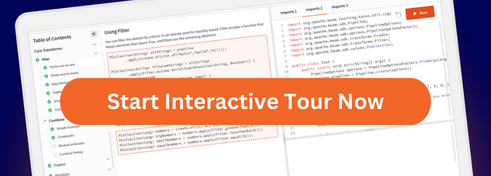Apache Beam Documentation
This page provides links to conceptual information and reference material for the Beam programming model, SDKs, and runners.
Concepts
Learn about the Beam Programming Model and the concepts common to all Beam SDKs and Runners.
- Start with the Basics of the Beam model for introductory conceptual information.
- Read the Programming Guide, which has more detailed information about the Beam concepts and provides code snippets.
- Learn about Beam’s execution model to better understand how pipelines execute.
- Visit Learning Resources for some of our favorite articles and talks about Beam.
- Reference the glossary to learn the terminology of the Beam programming model.
Pipeline Fundamentals
- Design Your Pipeline by planning your pipeline’s structure, choosing transforms to apply to your data, and determining your input and output methods.
- Create Your Pipeline using the classes in the Beam SDKs.
- Test Your Pipeline to minimize debugging a pipeline’s remote execution.
SDKs
Find status and reference information on all of the available Beam SDKs.
Transform catalogs
Beam’s transform catalogs contain explanations and code snippets for Beam’s built-in transforms.
Runners
A Beam Runner runs a Beam pipeline on a specific (often distributed) data processing system.
Available Runners
Runs locally on your machine – great for developing, testing, and debugging.
Runs on Apache Flink.
Runs on Apache Spark.
Runs on Google Cloud Dataflow, a fully managed service within Google Cloud Platform.
Runs on Apache Samza.
Runs on Apache Nemo.
- JetRunner: Runs on Hazelcast Jet.
- Twister2Runner: Runs on Twister2.
Choosing a Runner
Beam is designed to enable pipelines to be portable across different runners. However, given every runner has different capabilities, they also have different abilities to implement the core concepts in the Beam model. The Capability Matrix provides a detailed comparison of runner functionality.
Once you have chosen which runner to use, see that runner’s page for more
information about any initial runner-specific setup as well as any required or
optional PipelineOptions for configuring its execution. You might also want to
refer back to the Quickstart for Java,
Python or Go for
instructions on executing the sample WordCount pipeline.
Last updated on 2024/04/16
Have you found everything you were looking for?
Was it all useful and clear? Is there anything that you would like to change? Let us know!



